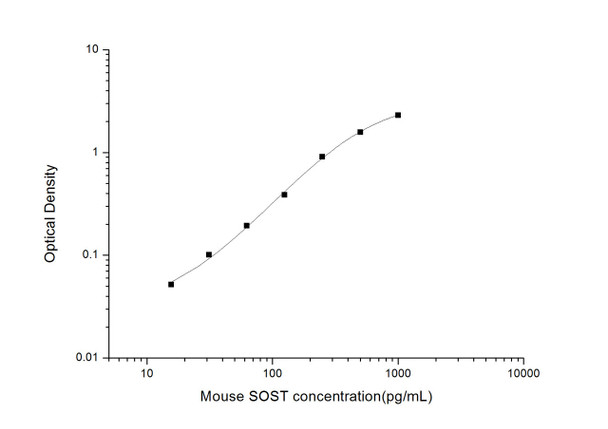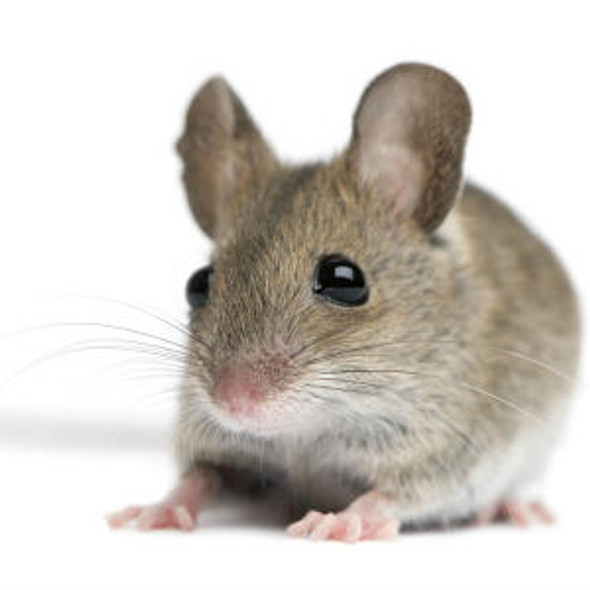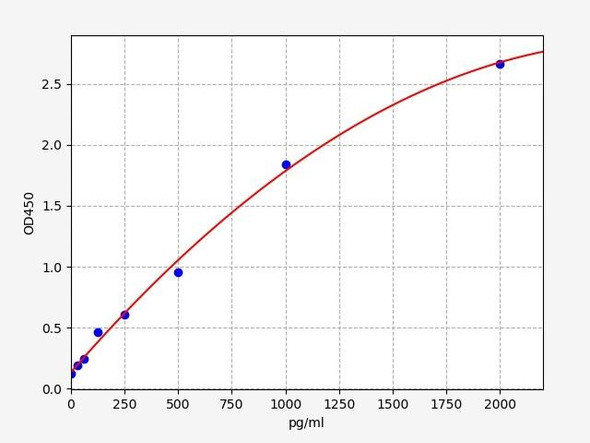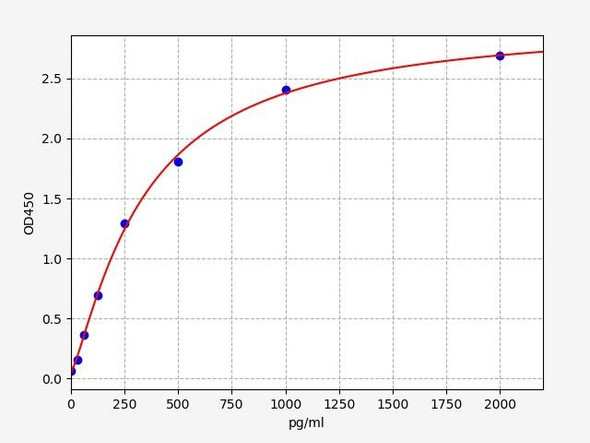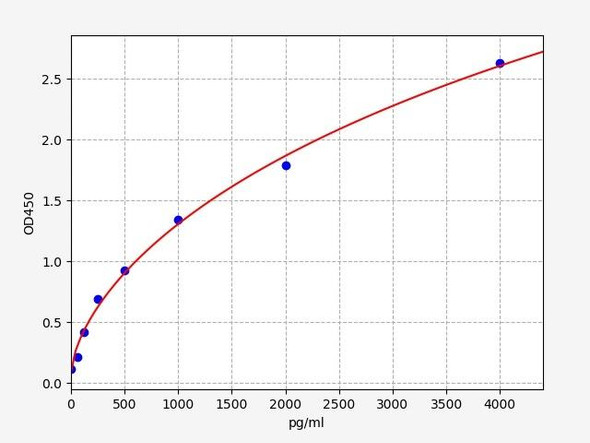Mouse Metabolism ELISA Kits
Mouse SOST (Sclerostin) ELISA Kit (MOES01714)
- SKU:
- MOES01714
- Product Type:
- ELISA Kit
- Size:
- 96 Assays
- Uniprot:
- Q99P68
- Sensitivity:
- 9.38pg/mL
- Range:
- 15.63-1000pg/mL
- ELISA Type:
- Sandwich
- Synonyms:
- CDD, VBCH
- Reactivity:
- Mouse
- Sample Type:
- Serum, plasma and other biological fluids
- Research Area:
- Metabolism
Description
| Assay type: | Sandwich |
| Format: | 96T |
| Assay time: | 4.5h |
| Reactivity: | Mouse |
| Detection Method: | Colormetric |
| Detection Range: | 15.63-1000 pg/mL |
| Sensitivity: | 9.38 pg/mL |
| Sample Volume Required Per Well: | 100µL |
| Sample Type: | Serum, plasma and other biological fluids |
| Specificity: | This kit recognizes Mouse SOST in samples. No significant cross-reactivity or interference between Mouse SOST and analogues was observed. |
This ELISA kit uses Sandwich-ELISA as the method. The micro ELISA plate provided in this kit has been pre-coated with an antibody specific to Mouse SOST. Standards or samples are added to the appropriate micro ELISA plate wells and combined with the specific antibody. Then a biotinylated detection antibody specific for Mouse SOST and Avidin-Horseradish Peroxidase (HRP) conjugate are added to each micro plate well successively and incubated. Free components are washed away. The substrate solution is added to each well. Only those wells that contain Mouse SOST, biotinylated detection antibody and Avidin-HRP conjugate will appear blue in color. The enzyme-substrate reaction is terminated by adding Stop Solution and the color turns yellow. The optical density (OD) is measured spectrophotometrically at a wavelength of 450 nm ± 2 nm. The OD value is proportional to the concentration of Mouse SOST. The concentration of Mouse SOST in samples can be calculated by comparing the OD of the samples to the standard curve.
| UniProt Protein Function: | SOST: Negative regulator of bone growth that acts through inhibition of Wnt signaling and bone formation. Defects in SOST are the cause of sclerosteosis type 1 (SOST1). An autosomal recessive sclerosing bone dysplasia characterized by a generalized hyperostosis and sclerosis leading to a markedly thickened skull, with mandible, ribs, clavicles and all long bones also being affected. Due to narrowing of the foramina of the cranial nerves, facial nerve palsy, hearing loss and atrophy of the optic nerves can occur. Sclerosteosis is clinically and radiologically very similar to van Buchem disease, mainly differentiated by hand malformations and a large stature in sclerosteosis patients. Defects in SOST are a cause of van Buchem disease (VBCH). An autosomal recessive sclerosing bone dysplasia characterized by endosteal hyperostosis of the mandible, skull, ribs, clavicles, and diaphyses of the long bones. Affected patients present a symmetrically increased thickness of bones, most frequently found as an enlarged jawbone, but also an enlargement of the skull, ribs, diaphysis of long bones, as well as tubular bones of hands and feet. The clinical consequence of increased thickness of the skull include facial nerve palsy causing hearing loss, visual problems, neurological pain, and, very rarely, blindness as a consequence of optic atrophy. Serum alkaline phosphatase levels are elevated. A 52 kb deletion downstream of SOST results in SOST transcription suppression causing van Buchem disease. Defects in SOST are a cause of craniodiaphyseal dysplasia autosomal dominant (CDD). A severe bone dysplasia characterized by massive generalized hyperostosis and sclerosis, especially involving the skull and facial bones. The sclerosis is so severe that the resulting facial distortion is referred to as 'leontiasis ossea' (leonine faces) and the bone deposition results in progressive stenosis of craniofacial foramina. Respiratory obstruction due to choanal stenosis compromises the clinical outcomes of affected patients. Heterozygous mutations located in the secretion signal of the SOST gene prevent sclerostin secretion and can be responsible for craniodiaphyseal dysplasia. Belongs to the sclerostin family. 2 isoforms of the human protein are produced by alternative splicing. |
| UniProt Protein Details: | Protein type:Secreted; Secreted, signal peptide Cellular Component: Golgi apparatus; extracellular matrix; proteinaceous extracellular matrix; extracellular space; extracellular region Molecular Function:heparin binding; protein binding; transcription factor binding Biological Process: ossification; negative regulation of Wnt receptor signaling pathway; Wnt receptor signaling pathway; positive regulation of transcription, DNA-dependent; negative regulation of ossification; negative regulation of protein complex assembly; negative regulation of BMP signaling pathway |
| UniProt Code: | Q99P68 |
| NCBI GenInfo Identifier: | 20140197 |
| NCBI Gene ID: | |
| NCBI Accession: | Q99P68. 1 |
| Molecular Weight: | |
| NCBI Full Name: | Sclerostin |
| UniProt Protein Name: | Sclerostin |
| Protein Family: | Sclerostin |
| UniProt Gene Name: | Sost |
| UniProt Entry Name: | SOST_MOUSE |
As the OD values of the standard curve may vary according to the conditions of the actual assay performance (e. g. operator, pipetting technique, washing technique or temperature effects), the operator should establish a standard curve for each test. Typical standard curve and data is provided below for reference only.
| Concentration (pg/mL) | O.D | Average | Corrected |
| 1000 | 2.37 2.418 | 2.394 | 2.315 |
| 500 | 1.654 1.668 | 1.661 | 1.582 |
| 250 | 1.008 0.972 | 0.99 | 0.911 |
| 125 | 0.46 0.476 | 0.468 | 0.389 |
| 62.5 | 0.283 0.263 | 0.273 | 0.194 |
| 31.25 | 0.187 0.173 | 0.18 | 0.101 |
| 15.63 | 0.121 0.141 | 0.131 | 0.052 |
| 0 | 0.069 0.089 | 0.079 | -- |
Precision
Intra-assay Precision (Precision within an assay): 3 samples with low, mid range and high level Mouse SOST were tested 20 times on one plate, respectively.
Inter-assay Precision (Precision between assays): 3 samples with low, mid range and high level Mouse SOST were tested on 3 different plates, 20 replicates in each plate.
| Intra-assay Precision | Inter-assay Precision | |||||
| Sample | 1 | 2 | 3 | 1 | 2 | 3 |
| n | 20 | 20 | 20 | 20 | 20 | 20 |
| Mean (pg/mL) | 51.25 | 122.43 | 333.91 | 53.00 | 125.83 | 361.81 |
| Standard deviation | 3.14 | 6.78 | 10.22 | 3.41 | 7.13 | 15.12 |
| C V (%) | 6.13 | 5.54 | 3.06 | 6.43 | 5.67 | 4.18 |
Recovery
The recovery of Mouse SOST spiked at three different levels in samples throughout the range of the assay was evaluated in various matrices.
| Sample Type | Range (%) | Average Recovery (%) |
| Serum (n=5) | 89-102 | 95 |
| EDTA plasma (n=5) | 92-110 | 100 |
| Cell culture media (n=5) | 84-99 | 91 |
Linearity
Samples were spiked with high concentrations of Mouse SOST and diluted with Reference Standard & Sample Diluent to produce samples with values within the range of the assay.
| Serum (n=5) | EDTA plasma (n=5) | Cell culture media (n=5) | ||
| 1:2 | Range (%) | 87-98 | 96-110 | 96-113 |
| Average (%) | 93 | 101 | 103 | |
| 1:4 | Range (%) | 92-107 | 82-94 | 82-96 |
| Average (%) | 97 | 86 | 88 | |
| 1:8 | Range (%) | 88-104 | 86-97 | 88-103 |
| Average (%) | 95 | 92 | 95 | |
| 1:16 | Range (%) | 91-104 | 82-95 | 84-96 |
| Average (%) | 97 | 88 | 89 |
An unopened kit can be stored at 4°C for 1 month. If the kit is not used within 1 month, store the items separately according to the following conditions once the kit is received.
| Item | Specifications | Storage |
| Micro ELISA Plate(Dismountable) | 8 wells ×12 strips | -20°C, 6 months |
| Reference Standard | 2 vials | |
| Concentrated Biotinylated Detection Ab (100×) | 1 vial, 120 µL | |
| Concentrated HRP Conjugate (100×) | 1 vial, 120 µL | -20°C(shading light), 6 months |
| Reference Standard & Sample Diluent | 1 vial, 20 mL | 4°C, 6 months |
| Biotinylated Detection Ab Diluent | 1 vial, 14 mL | |
| HRP Conjugate Diluent | 1 vial, 14 mL | |
| Concentrated Wash Buffer (25×) | 1 vial, 30 mL | |
| Substrate Reagent | 1 vial, 10 mL | 4°C(shading light) |
| Stop Solution | 1 vial, 10 mL | 4°C |
| Plate Sealer | 5 pieces | |
| Product Description | 1 copy | |
| Certificate of Analysis | 1 copy |
- Set standard, test sample and control (zero) wells on the pre-coated plate and record theirpositions. It is recommended to measure each standard and sample in duplicate. Note: addall solutions to the bottom of the plate wells while avoiding contact with the well walls. Ensuresolutions do not foam when adding to the wells.
- Aliquot 100µl of standard solutions into the standard wells.
- Add 100µl of Sample / Standard dilution buffer into the control (zero) well.
- Add 100µl of properly diluted sample (serum, plasma, tissue homogenates and otherbiological fluids) into test sample wells.
- Cover the plate with the sealer provided in the kit and incubate for 90 min at 37°C.
- Aspirate the liquid from each well, do not wash. Immediately add 100µL of BiotinylatedDetection Ab working solution to each well. Cover the plate with a plate seal and gently mix. Incubate for 1 hour at 37°C.
- Aspirate or decant the solution from the plate and add 350µL of wash buffer to each welland incubate for 1-2 minutes at room temperature. Aspirate the solution from each well andclap the plate on absorbent filter paper to dry. Repeat this process 3 times. Note: a microplatewasher can be used in this step and other wash steps.
- Add 100µL of HRP Conjugate working solution to each well. Cover with a plate seal andincubate for 30 min at 37°C.
- Aspirate or decant the solution from each well. Repeat the wash process for five times asconducted in step 7.
- Add 90µL of Substrate Reagent to each well. Cover with a new plate seal and incubate forapproximately 15 min at 37°C. Protect the plate from light. Note: the reaction time can beshortened or extended according to the actual color change, but not by more than 30min.
- Add 50 µL of Stop Solution to each well. Note: Adding the stop solution should be done inthe same order as the substrate solution.
- Determine the optical density (OD value) of each well immediately with a microplate readerset at 450 nm.

